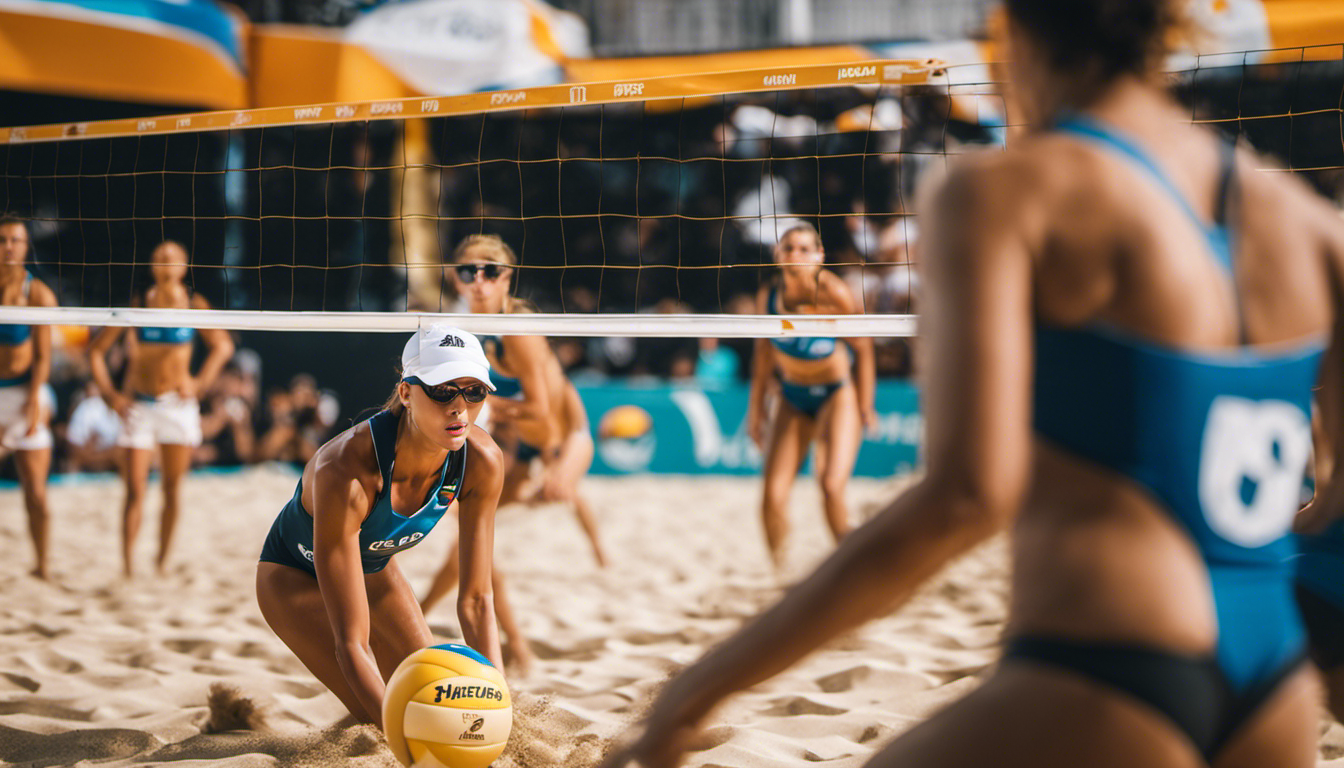I’ve always loved playing volleyball, but I recently discovered that there are some key differences between beach volleyball and indoor volleyball.
In this article, we’ll dive into the rules, equipment, gameplay, and more to help you understand these two versions of the sport.
Whether you’re a seasoned player or just starting out, knowing the distinctions between beach and indoor volleyball will give you a greater appreciation for both games.
Let’s get started!
Key Takeaways
- Beach volleyball is played on sand, while indoor volleyball is played on a hard court.
- Beach volleyball allows players to touch the ball with any body part, while indoor volleyball prohibits catching or holding the ball.
- Beach volleyball uses rally scoring, while indoor volleyball uses a rotation system.
- Beach volleyball requires different equipment and attire compared to indoor volleyball, with a smaller and lighter ball and swimsuits being used.
Rules and Regulations

Beach volleyball and indoor volleyball have different rules and regulations.
When it comes to fouls and penalties, both versions of the sport have their own set of guidelines.
In beach volleyball, players are allowed to touch the ball with any part of their body as long as they don’t hold or throw it.
On the other hand, in indoor volleyball, players are not allowed to catch or hold the ball at any point during play.
As for the scoring system, beach volleyball follows a rally scoring format where points can be scored by either team on every play.
Indoor volleyball, however, uses a rotation system where only the serving team has an opportunity to score points.
Understanding these rule differences is crucial for players transitioning between indoor and beach volleyball.
Playing Surface

The playing surface for beach volleyball is typically sand, while indoor volleyball is played on a hard court. The choice of surface has a significant impact on the game and its dynamics.
Here are some key differences between playing on sand and hardwood:
-
Sand:
-
Provides a softer landing surface, reducing the risk of injuries.
-
Requires players to exert more effort due to the resistance created by moving through loose sand.
-
Weather conditions such as wind can greatly affect gameplay, making it challenging to control the ball.
-
Hardwood:
-
Offers a faster and more predictable playing environment.
-
Enables players to make quicker movements and jumps with less effort.
-
Weather conditions have minimal impact indoors, ensuring consistent gameplay regardless of external factors.
Equipment and Attire
Players in beach volleyball typically wear swimsuits and use a smaller, lighter ball compared to indoor volleyball. The attire for beach volleyball is designed to be more suitable for the outdoor environment and allows players to move freely in the sand. In contrast, indoor volleyball players usually wear jerseys and shorts or spandex. The equipment used in beach volleyball also differs from indoor volleyball. Beach volleyballs are slightly smaller and lighter, making them easier to control on the sandy surface. Indoor volleyballs are larger and heavier, allowing for more power and speed during gameplay. Here is a table that summarizes some of the key differences in equipment between beach volleyball and indoor volleyball:
| Equipment | Beach Volleyball | Indoor Volleyball |
|---|---|---|
| Ball Size | Smaller | Larger |
| Ball Weight | Lighter | Heavier |
| Attire | Swimsuits | Jerseys/Shorts/Spandex |
These differences in attire and equipment contribute to the unique nature of both versions of the sport.
Team Size and Positions

In team beach volleyball, you and your partner will have to strategize and work together in order to cover the court effectively. The success of your team relies on understanding different team formations and player roles. Here are some key points to consider:
-
Team Formations:
-
2-0 Formation: One player takes the front of the court while the other stays at the back.
-
1-1 Formation: Both players split the court, with one covering half of it at a time.
-
0-2 Formation: This formation involves both players staying at the back of the court.
-
Player Roles:
-
Blocker: This player is responsible for blocking shots at the net.
-
Defender/Libero: The defender focuses on receiving serves and making defensive plays.
-
Setter: The setter’s main role is to set up their partner for an attack.
Gameplay and Strategy

When playing team beach volleyball, it’s important to develop effective gameplay strategies in order to outsmart your opponents.
Offensive tactics play a crucial role in scoring points and putting pressure on the opposing team. One popular offensive strategy is the ‘cut shot,’ where the hitter aims for an angle between the block and defense. Another tactic is the ‘joust,’ where players try to dominate at the net by pushing their opponent’s hands back with a powerful attack.
On the other hand, defensive strategies are essential for preventing your opponents from scoring. These may include blocking, digging, and positioning yourself strategically on the court to anticipate your opponent’s attacks.
Effective communication among teammates is also vital in executing both offensive tactics and defensive strategies successfully.
Frequently Asked Questions
What Are the Health Benefits of Playing Beach Volleyball Compared to Indoor Volleyball?
Playing beach volleyball compared to indoor volleyball offers unique health benefits. The sand provides a natural resistance, increasing muscle strength and endurance. Additionally, the uneven surface helps improve balance and stability, reducing the risk of injuries.
How Does the Playing Environment Affect the Gameplay and Performance of the Players in Beach Volleyball?
The playing environment has a significant impact on gameplay and player performance in beach volleyball. Factors such as weather conditions can affect the ball movement, visibility, and player agility, making it a unique and challenging sport compared to indoor volleyball.
Are There Any Specific Strategies or Techniques Unique to Beach Volleyball That Are Not Used in Indoor Volleyball?
There are specific techniques and strategies unique to beach volleyball that aren’t used in indoor volleyball. These include playing with the wind, adjusting to the sand, and utilizing the smaller court for more strategic plays.
What Are the Common Challenges or Obstacles Players Face While Playing Beach Volleyball?
When playing beach volleyball, challenges and obstacles can arise due to the sand’s uneven surface, unpredictable weather conditions, and the need for constant communication between partners.
How Does the Level of Physical Fitness Required for Beach Volleyball Differ From Indoor Volleyball?
In beach volleyball, the physical demands are different compared to indoor volleyball. The training regimen focuses on building endurance, agility, and strength to handle the challenges of playing on sand.
Conclusion
In conclusion, beach volleyball and indoor volleyball may seem similar at first glance, but there are distinct differences between the two.
From the rules and regulations to the playing surface, equipment, attire, team size and positions, as well as gameplay and strategy, each version of the sport offers its own unique experience.
Whether you prefer the sand under your feet or the controlled environment of a court, both forms of volleyball offer exhilarating competition and require skillful teamwork.
So grab a ball and get ready to spike it on the beach or in an indoor arena – either way, you’re in for an exciting game!



